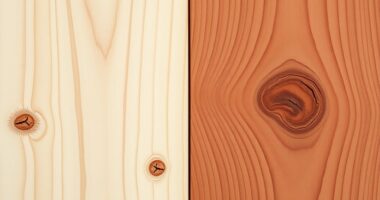To tell oak from ash, look closely at the grain patterns. Oak has a coarse, textured grain with wide annual rings and prominent rays that run perpendicular, giving it a rugged appearance. It also features large, open pores visible to the naked eye. Ash, in contrast, has finer, more uniform grain with narrower rings, less visible rays, and smaller pores, resulting in a smoother look. Keep exploring to uncover more tips for accurate identification.
Key Takeaways
- Oak has prominent, textured grain with wide annual rings and visible rays, unlike ash’s finer, more uniform grain with less noticeable rays.
- Oak features large, open pores creating a porous surface, whereas ash has smaller, less conspicuous pores for a smoother appearance.
- The presence of distinct rays perpendicular to growth rings helps identify oak; ash rays are subtler or barely visible.
- Oak’s rugged surface and textured grain contrast with ash’s straight, smooth grain and lighter color.
- Examining pore size, ray visibility, and grain pattern using magnification aids in accurately distinguishing oak from ash.

Have you ever struggled to tell oak and ash trees apart? It’s a common challenge, especially when you’re examining wood or trying to identify a tree in the wild. The key lies in understanding their distinct wood grain patterns and using effective wood identification techniques. These methods help you distinguish between the two, even when the wood looks similar at first glance. When you look at oak wood, you’ll notice a prominent, coarse grain pattern. The annual rings tend to be wide and clearly defined, giving the surface a rugged appearance. Oak often displays a pattern of distinct rays—those are the narrow bands of cells that run perpendicular to the growth rings—making the grain look more textured and intricate. The pores in oak are generally large and open, creating a porous surface that’s easy to feel and see. These pores sometimes appear as tiny holes or specks when you look closely, especially in the cross-section. Using wood identification techniques, you’ll want to examine the grain closely with a hand lens or microscope, paying attention to the size and arrangement of pores and rays. Advances in home cinema technology, such as high-resolution imaging, can aid in detailed analysis of wood grain features. Ash wood, on the other hand, exhibits a much more uniform and finer grain pattern. The annual rings are often narrower, and the texture appears smoother compared to oak. The rays in ash are usually less pronounced, sometimes barely visible to the naked eye, giving the wood a more subtle, consistent appearance. The pores in ash tend to be smaller and less conspicuous, which results in a more even surface. When you’re trying to identify ash, you might notice the wood’s light color and straight grain that runs consistently along the length of the piece. To confirm, you can perform simple tests, such as looking for the presence of medullary rays or conducting a burn test to observe the flame and ash characteristics—these are part of effective wood identification techniques.
Frequently Asked Questions
Can Surface Finishes Obscure Wood Grain Differences?
Surface finishes can definitely obscure wood grain differences, making it harder for you to distinguish between oak and ash. A glossy or thick coating can hide the natural grain pattern and surface texture, so you might miss subtle cues. To accurately identify the wood, consider examining the grain when the finish is light or partially worn. This way, you can better observe the unique characteristics that set oak and ash apart.
Are There Specific Tools Best for Distinguishing Oak From Ash?
You can use a hand lens or a magnifying glass to examine the wood’s grain pattern more clearly, which helps distinguish oak from ash. A fine-toothed saw or a chisel can reveal pore structures and ray patterns more effectively. Your goal is to choose tools that allow close inspection without damaging the surface, making it easier to identify the differences in grain pattern and pore distribution between these woods.
How Does Aging Affect the Appearance of Oak and Ash?
As your oak and ash age, you’ll notice subtle changes. Oak tends to darken with age due to age-related color change, deepening its warm tones. Ash, however, usually lightens slightly or develops a more muted hue. Surface wear effects become more evident over time, with scratches and dents blending into the wood’s patina. These aging effects can enhance the character of both woods, giving your piece a richer, more distinguished look.
Do Regional Growth Conditions Influence Wood Characteristics?
Imagine you’re choosing between oak and ash for a furniture project; regional growth conditions really matter. Growth climate influences wood characteristics, causing regional variation in grain tightness and color. For example, oak grown in cooler, wetter climates may develop denser, darker grains, while ash from warmer regions might be lighter and more porous. These differences help you select the best wood based on your specific aesthetic and structural needs.
Can Synthetic or Composite Woods Mimic Oak or Ash?
Synthetic imitation and composite materials can closely mimic oak or ash, but they often lack the natural grain and texture. You can find products designed to replicate the appearance and feel of these woods, making them suitable for furniture or décor. However, if you look closely, you’ll notice differences in grain patterns and pore details. These materials offer durability and cost benefits but may not fully capture the authentic character of real oak or ash.
Conclusion
By recognizing the subtle differences in rays, pores, and grain, you become a skilled explorer traversing the forest of wood types. Think of oak and ash as two musical instruments—each with its unique tone—revealed through careful observation. With this knowledge, you’ll confidently distinguish them, transforming your understanding into a finely tuned sense of craftsmanship. Ultimately, mastering these details turns you into a true connoisseur, orchestrating beauty from nature’s intricate symphony.








